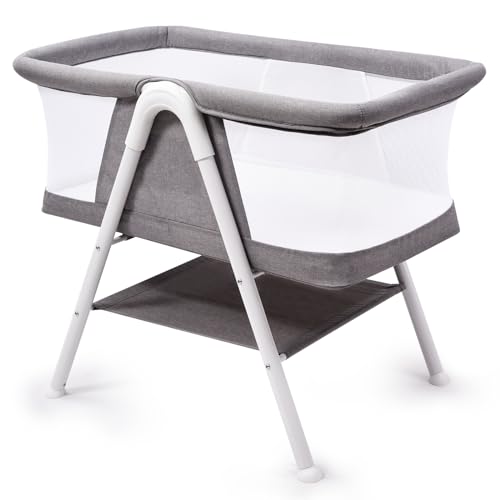Bedside Bassinet Isn't As Tough As You Think

The Ultimate Guide to Choosing a Bedside Bassinet: Safety, Comfort, and Convenience
Intro
As new parents step into the thrilling yet challenging world of child care, one necessary product that often tops the list is a bedside bassinet. These spaces serve as a safe sleeping location for newborns while allowing parents to preserve close distance during the night. With a myriad of choices readily available on the market today, understanding the functions, advantages, and considerations for a bedside bassinet can make a substantial difference in the overall parenting experience.
This short article will explore the various types of bedside bassinets, safety standards, key features to think about, and some frequently asked questions to help you make a notified decision.
What is a Bedside Bassinet?
A bedside bassinet is a sleeping space created for newborns and infants, typically utilized for the first few months of a baby's life. It is normally smaller sized than a crib and offers the convenience of being placed next to an adult bed, enabling parents to tend to their babies quickly during nighttime.
Kinds Of Bedside Bassinets
There are numerous types of bedside bassinets available, each created with unique features and benefits:
- Co-Sleeping Bassinets: These are developed to connect safely to the side of the moms and dad's bed, permitting easy access during nighttime feedings and reassuring without totally co-sleeping.
- Standalone Bassinets: These are free-standing variations that sit next to your bed however do not connect. While they use up more space, they can often use a bigger sleeping area.
- Travel Bassinets: Lightweight and portable, these bassinets are designed for households on the go. They can be folded or dismantled quickly, using convenience while taking a trip.
- Convertible Bassinets: Some models can change into cribs or playards, extending their lifespan and making them a more cost-effective choice.
Benefits of Using a Bedside Bassinet
Going with a bedside bassinet can give numerous benefits, consisting of:
- Convenience: Parents can easily access their baby throughout the night for feeding, reassuring, or diaper modifications without rising.
- Security: Bassinets are designed particularly for infants, frequently adhering to safety standards that help decrease the danger of Sudden Infant Death Syndrome (SIDS).
- Comfort: Babies can feel protected with their parents nearby, promoting a sense of safety that is favorable to much better sleep.
- Space-saving: Bedside bassinets are normally compact and easy to fit in smaller sized bedrooms.
Secret Safety Features to Consider
When selecting a bedside bassinet, guaranteeing safety is vital. Here are a couple of essential security features to consider:
- Stable Base: Ensure the bassinet has a durable structure that can not tip over easily. Inspect that wheels lock into place to prevent motion.
- Breathable Fabrics: Look for products that enable air circulation to minimize the risk of suffocation.
- Height Adjustability: A bassinette that gets used to the height of your bed can improve security and benefit.
- No Drop Sides: Select models that do not have drop sides, as they can pose a danger of the baby falling out or getting caught.
- Certification: Always ensure that the bassinet abides by security standards set by acknowledged firms like the American Academy of Pediatrics (AAP).
Additional Features to Look For
Aside from security, here are some additional functions to consider when searching for the ideal bedside bassinet:
- Storage Space: Some bassinets include built-in storage for basics like diapers, wipes, and attire.
- Rocking or Gliding Mechanism: This can help soothe babies who have difficulty calming down to sleep.
- Noise and Light Features: Some designs consist of soothing sounds, nightlights, or forecasts that can help soothe infants to sleep.
- Washable Components: Make sure removable covers and sheets are maker washable for easy cleansing.
Choosing the right bedside bassinet is an essential decision that can exceptionally influence the early parenting experience. By comprehending the different types available, their advantages, essential safety features, and additional benefits, parents can make an informed option to ensure both their baby's convenience and security.
Eventually, the best bedside bassinet ought to cater to specific family needs while improving the bond between parents and their newborns throughout those valuable first few months.
Frequently Asked Questions about Bedside Bassinets
1. For how long can I use a bedside bassinet for my baby?
Most bassinets are created for infants approximately about 4 to 6 months, or until the baby can roll over, pull up, or surpass the weight limitation specified by the maker (typically around 20-30 pounds).
2. Bedside Cot For Stylish Sleep Space for co-sleeping?
While bedside bassinets offer close proximity, it's important to guarantee they're safely connected to the bed. Always follow standards for safe sleeping to decrease the risk of SIDS.
3. Can I use a bedside bassinet for a premature baby?
Yes, lots of bedside bassinets can accommodate premature infants. However, it's important to talk to a pediatrician for suggestions based upon your baby's particular requirements.
4. What should I try to find in regards to mattress safety in a bedside bassinet?
Ensure that the mattress fits tightly against the sides of the bassinet without any spaces. The bed mattress should be firm and covered with a fitted sheet to reduce the risk of suffocation.
5. Are there any specific cleaning guidelines I should follow?
Many bassinets have removable covers that can be cleaned. Constantly follow the maker's directions for cleansing and maintaining the bassinet.
By resolving these concerns, parents can navigate the decision-making process concerning bedside bassinets more effectively, making sure safety and convenience as they welcome their youngster into the world.

